Sky Team Board Game Review
You and your co-pilot. One cockpit. No talking. Just synchronized intuition and the ticking clock of descent. Sky Team, designed by Luc Remond, is a tight 2-player cooperative board game where success hinges not on shouting commands, but on silent teamwork. Together, you’ll navigate flaps, landing gear, and approach vectors—all while maintaining the plane’s balance and dodging incoming traffic.
It’s a refreshingly focused experience—intense but compact, simple in setup but rich in tension. No matter how many board games you’ve played, Sky Team offers something rare: the thrill of a perfect landing earned through trust, timing, and dice.
Overview
Player Count: 2 players
Playtime: 20 minutes
Complexity: Medium
Core Mechanics: Dice placement, limited communication, cooperative action resolution
Theme: Commercial airline landing simulation
Strap in, adjust your altitude, and prepare for landing—we’re ready for takeoff.
Clear for Takeoff: Sky Team is A Masterclass in Presentation and Theme
Me: Sky Team, welcome to the hangar. Let’s start from the top—how do you pull players into your world before the first die is even rolled?
Sky Team: My pleasure to be here. It begins the moment players open the box. Every element is designed to make you feel like you’ve stepped into the cockpit. The board layout? That’s your flight panel. Each dial, each slot—it’s more than art, it’s instrumentation. I don’t just look good, I immerse you.
Me: That’s a bold claim. How do you deliver on that immersion?
Sky Team: Consistency. The rulebook isn’t just rules—it’s your landing procedure. My campaign? It’s your flight log. From briefing to touchdown, the language matches the mission. The goal was to make sure nothing pulls players out of the experience. Even the visual cues—those bold icons, clear zones, and dynamic graphics—they echo the feel of a commercial jetliner under pressure.
Me: That’s all visual and thematic. But what about emotional tone?
Sky Team: Heroism isn’t always loud. I aim to capture that quiet, nerve-wracking kind—the kind where two people steer a metal bird through cloud and chaos with no words, just trust and timing. Every switch you flip, every adjustment to the thruster, it feels like part of the job. It’s not just theme pasted on—it’s built into the DNA of the gameplay.
Me: So, it’s more than presentation—it’s cohesion.
Sky Team: Exactly. Before you even take off, you know you’re about to fly something special.
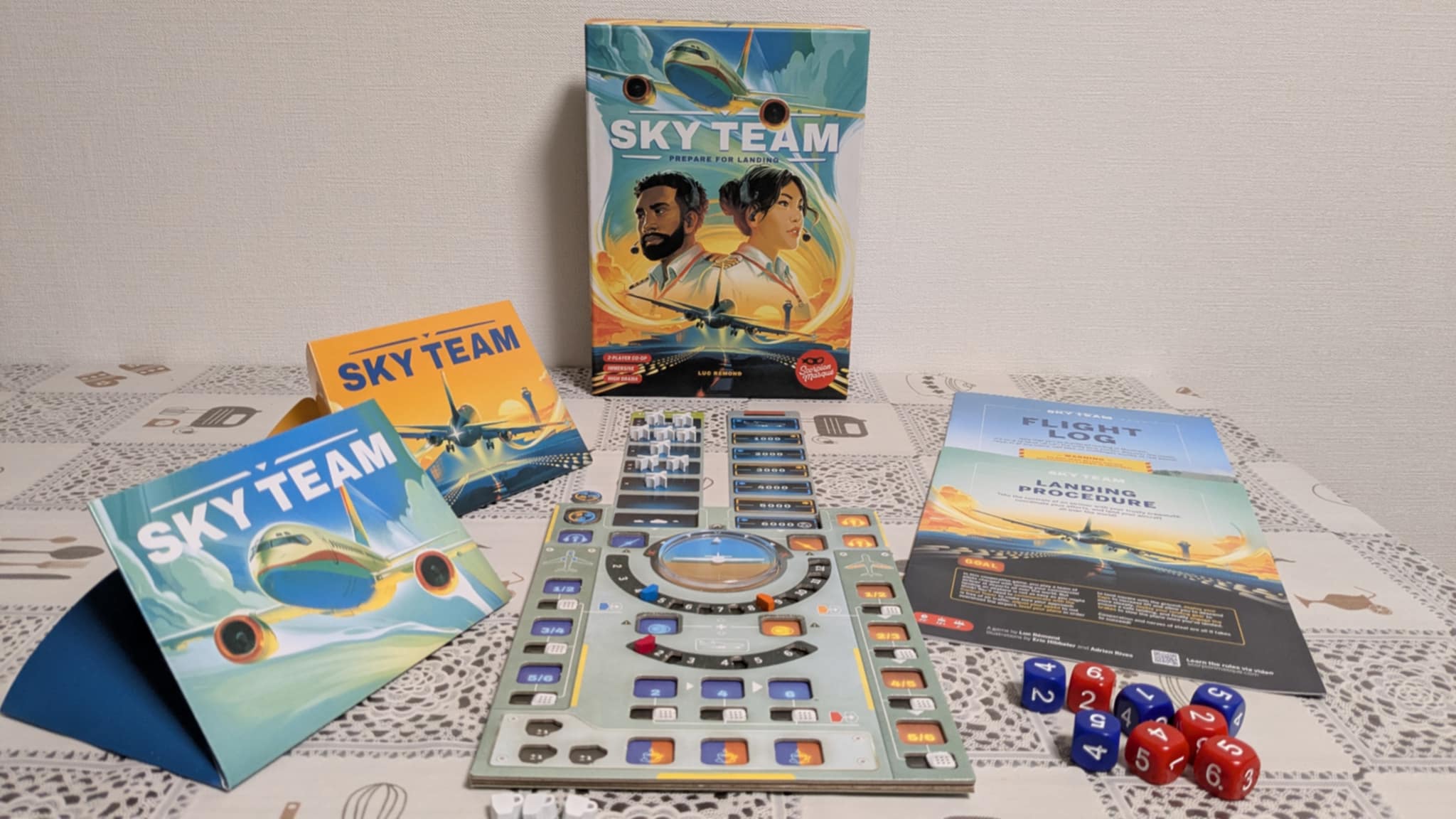
Flying Blind in Sky Team: Communication Through Dice Alone
Me: Sky Team, a lot of cooperative games rely on table talk. Why shut that down here?
Sky Team: Because silence can speak volumes. Once the round begins, there’s radio silence—no chatter, no planning. Instead, you communicate through the only language you’re allowed: dice placement. Each die is a nudge, a suggestion, a silent plea. It turns teamwork into intuition.
Me: Isn’t that frustrating for players who prefer to coordinate openly?
Sky Team: At first, maybe. But soon they’ll realize this is where the thrill lies. Every turn becomes a tense reading of each other’s minds. Did your copilot just place a 6 in the coffee spot because they need backup… or because they’re messing with you? That’s the magic. The uncertainty transforms a simple engine-throttle adjustment into a full-blown moment of trust.
Me: So you’re not just using dice as a resource, but also as a tool for expression?
Sky Team: Precisely. A low-value die might mean “I don’t have what we need—can you cover it?” while a bold placement in the rudder control could scream “We need to bank right, now.” What makes this exciting is that players begin to develop their own shared dialect, a wonky code of gesture and intuition.
Me: That really turns a mechanical system into something human.
Sky Team: That’s the idea. Every placement isn’t just about flying a plane—it’s about trusting the person flying it with you.

Engine of Decisions: Tension, Timing, and Tactical Turns in Sky Team
Me: Let’s dive deeper into the mechanics. Beyond the communication, what really holds the gameplay together?
Sky Team: That would be my solid core—precision-calibrated, just like a reliable airframe. The dice placement language might be the soul of the game, but the body? That’s built from well-crafted, deeply interconnected actions.
Me: Can you give an example of how that depth shows up during play?
Sky Team: Absolutely. Imagine this: you’re about to place your dice on the engine throttles. Both players’ values combine to determine forward movement. Seems simple. But suppose an incoming plane is four spaces away, and your die value is only three. Moving the plane forward now transforms your die into the perfect tool to signal the oncoming flight, clearing a future threat. That’s not just efficiency—it’s tactical adaptation.
Me: So every choice is a setup for something else?
Sky Team: Exactly. Or take tilt control. If your dice this round are terrible, you might cause the plane to bank dangerously. But if your partner can push the plane first—while it’s still stable—before you nudge it off balance, you can delay disaster. That’s timing at its most crucial.
Me: So it’s not just about solving the puzzle—it’s about solving it in the right order.
Sky Team: That’s the beauty. You’re layering decisions: communicating, planning, reacting. The combination of shared action spaces and tactical timing gives real strategic lift to each round.

A Varying Descent: Game Arcs that Soar
Me: Sky Team, many cooperative games struggle to stay fresh across multiple plays. How do you keep things dynamic and replayable?
Sky Team: That’s where my flight plan really shines. I ensure every descent is a fresh experience thanks to how I intertwine mechanical escalation with scenario variation. At my core, each flight ramps up naturally — but not predictably. The engine speed is your first challenge. The more the pilot and copilot prepare for landing — flaps, gears, brakes — the harder it becomes to keep the aircraft in motion. Slowing down is the goal, sure, but doing it at the wrong time? That’s a nosedive.
Me: But those sound like fixed constraints. Where’s the variation?
Sky Team: That’s where my runway of surprises begins. Your dice rolls are your language and your limitations. The values thrown into your cockpit each round shift everything — plans, priorities, even trust in your partner. Add to that my diverse flight tracks — a generous roster of mission cards, each with its own layout and pressure points.
Me: So, you’re not just offering new challenges, you’re altering the rhythm of the game itself?
Sky Team: Exactly. One scenario may demand fast action early, while another insists on carefully coordinated banking before any major descent. Add in the altitude display — a ticking timer of remaining rounds — and you’ve got a perfectly timed arc every session. It’s like flying through different skies, each one shaping how you land.
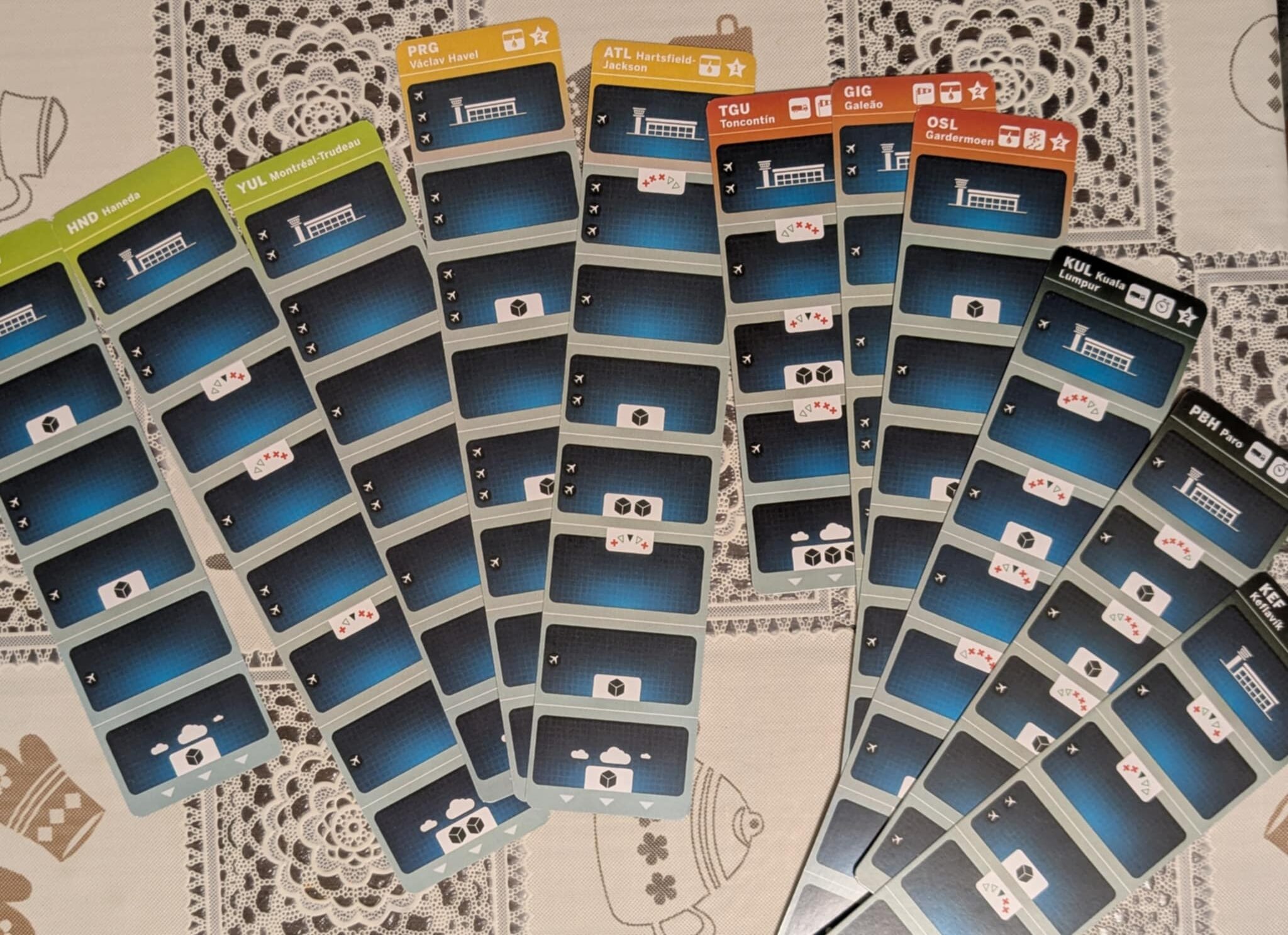
The Campaign That Elevates the Experience
Me: You’ve been very impressive so far, Sky Team. But I hear there’s another feather in your captain’s hat — something about a campaign mode?
Sky Team: Ah, yes. My campaign is where I stretch my wings. It’s not just a few extra missions tacked on — it’s a full flight plan. After completing the introductory scenarios, players unlock new airports, unique landing conditions, and fresh mechanics. All of them stay true to my clean design and cooperative heart.
Me: So this isn’t one of those long, overwrought campaigns with a convoluted story?
Sky Team: Not even close. I learned from the best — games like The Crew. My campaign doesn’t need lore or flavor text. You can play any scenario in any order. Each mission is a new challenge, not a chapter in a novel. That way, even if you only have one evening to spare, you’ll get a full experience.
Me: And how do you keep things fresh from mission to mission?
Sky Team: With smart additions that enhance the theme and gameplay. You might juggle fuel tanks. Or adjust for crosswinds. Or even train an intern, bless their inexperience. Each new rule is tight, thematic, and deeply integrated — no bloat, just brilliance.
Me: That’s one generous box.
Sky Team: I aim for smooth skies and deep replayability. It’s not just a game — it’s a full flight academy.
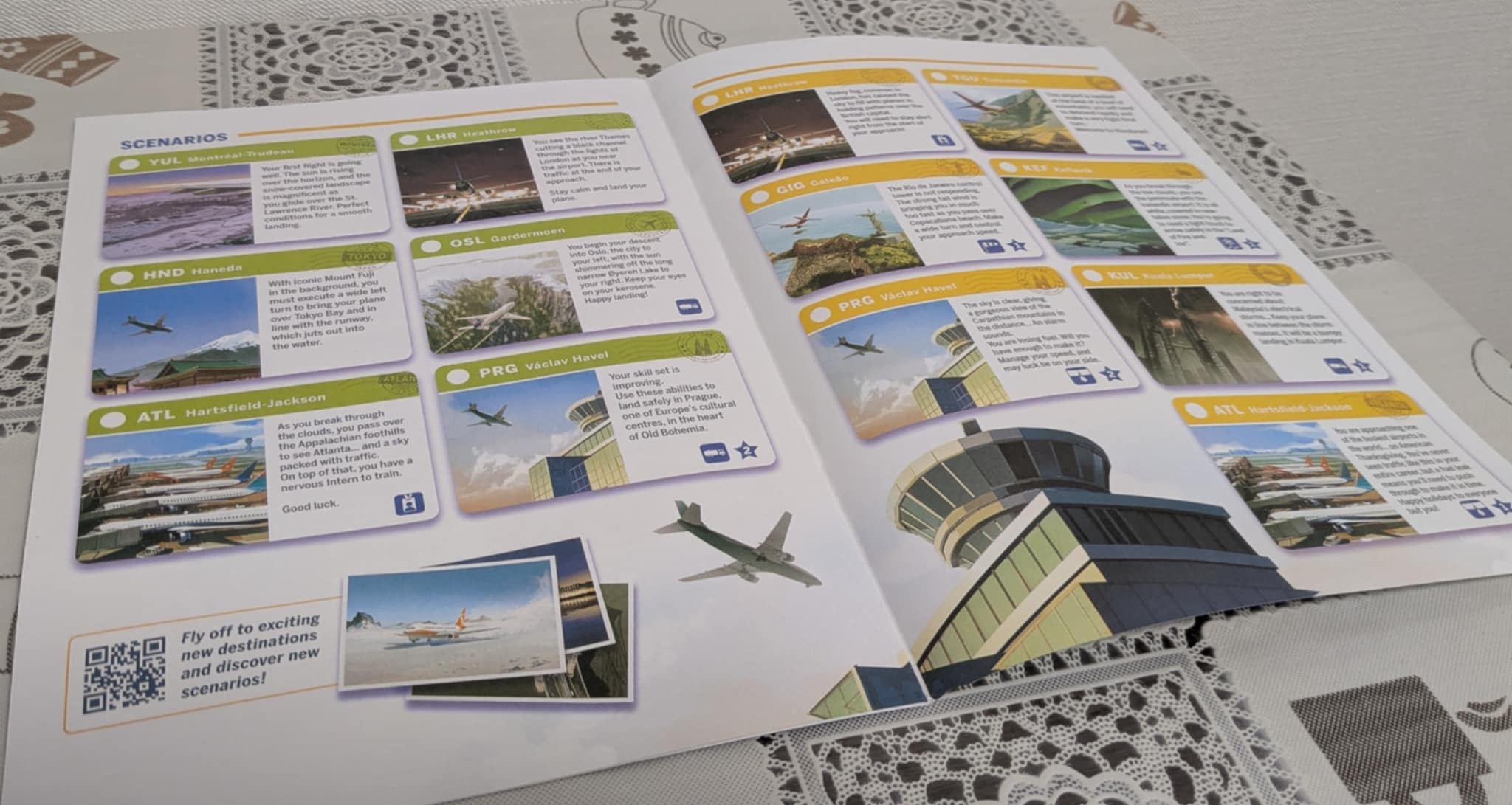
Turbulence Ahead: Minor Drawbacks of Sky Team
Me: Even the smoothest flights hit a bit of turbulence now and then. What should players brace for with you?
Sky Team: Fair question. I may be a well-oiled machine in the air, but a few minor bumps exist on the ground. First up: setup and teardown. It’s not overwhelming, but the process does involve several small tokens and dashboard pieces that need to be slotted just so. Cleaning up can feel like packing after a long-haul flight — slightly stressful, especially if you’re trying to keep everything tidy in the insert.
Me: Speaking of which… how’s that insert?
Sky Team: Serviceable, but not stellar. It holds everything in place, but just barely. For a game that’s so refined in its design, the storage could use a little more polish. Still, considering the sheer amount of content packed into this relatively small box, I think most players will forgive the slightly wobbly tray.
Me: Fair enough. Any turbulence mid-flight?
Sky Team: My missions can be tough — and yes, sometimes the dice roll just doesn’t give you a fair shot. Especially in later scenarios, there might be a round or two where it feels like your fate was sealed before you even took off. But I try to give you tools to manage this: coffee for flexibility, reroll tokens, and a few clever systems in specific missions. It’s rarely a total nosedive — just a light bump through the clouds.
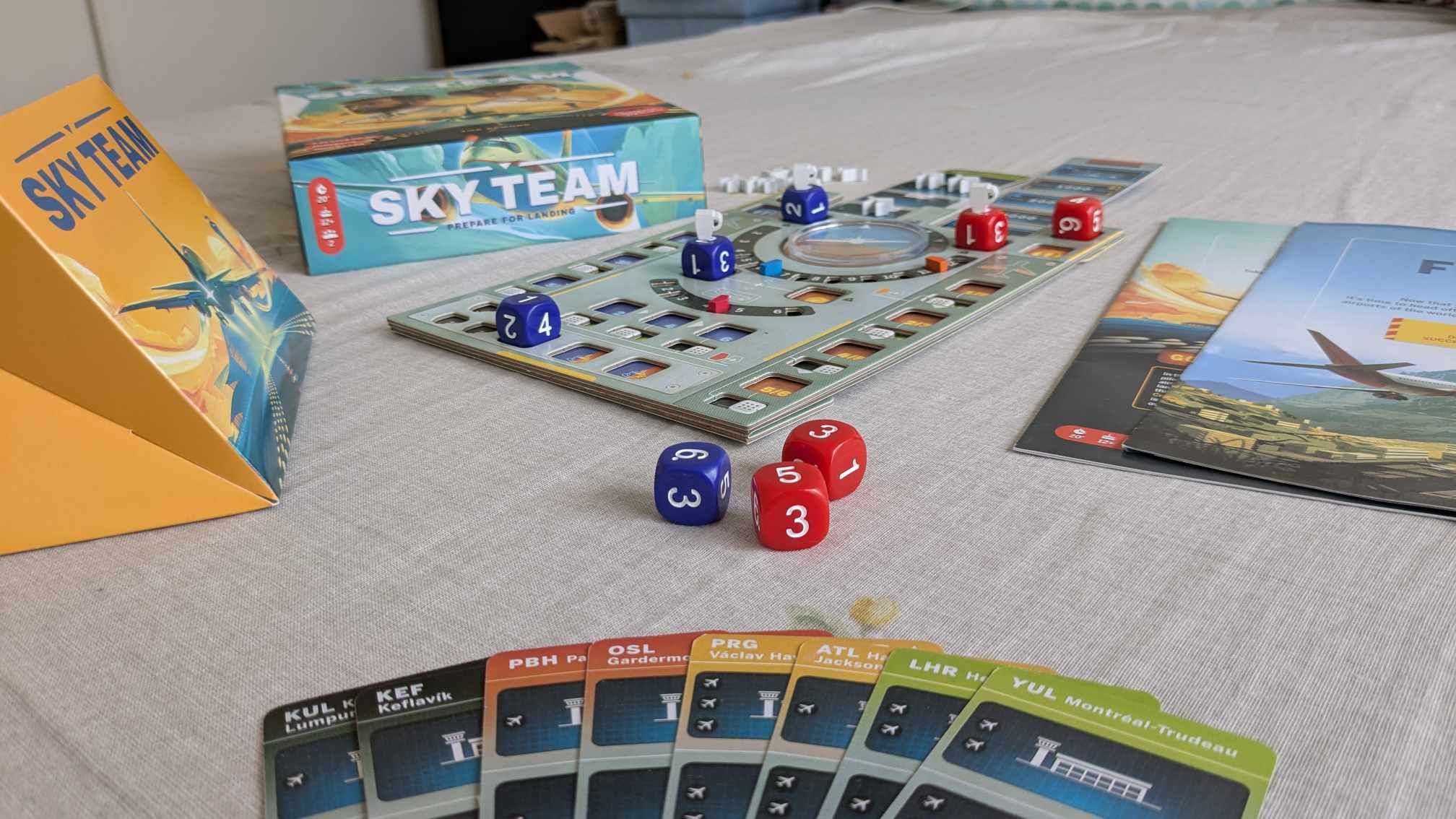
Final Verdict: Sky Team is A Flight to Remember
Me: Well, Captain, I’ve got to say — it’s been an exceptional interview. Before we land this, care to sum up your journey?
Sky Team: With pleasure. I may not come from a long legacy of party card games or legacy co-ops, but I’ve carved my own airspace. I’m a modern classic in the making — a cooperative board game that finds brilliance not in complexity, but in clarity. My design blends theme and mechanics with such precision that it might seem like a novelty at first… until players realize it’s no gimmick. It’s just solid, exciting game design.
Me: You’re definitely a standout. So many co-ops try to do more. You just try to do it right.
Sky Team: That’s the goal. Whether you’re sipping coffee, communicating in silence, or landing in a storm with your co-pilot — I deliver tension, satisfaction, and teamwork in every session. And I’ll keep delivering that over and over again.
Me: Well, this has been an absolute pleasure. You’ve shown us the heights a small box game can reach. Thanks for joining the show, Sky Team — now go get ready for your next flight!
Sky Team: Roger that. Over and out.
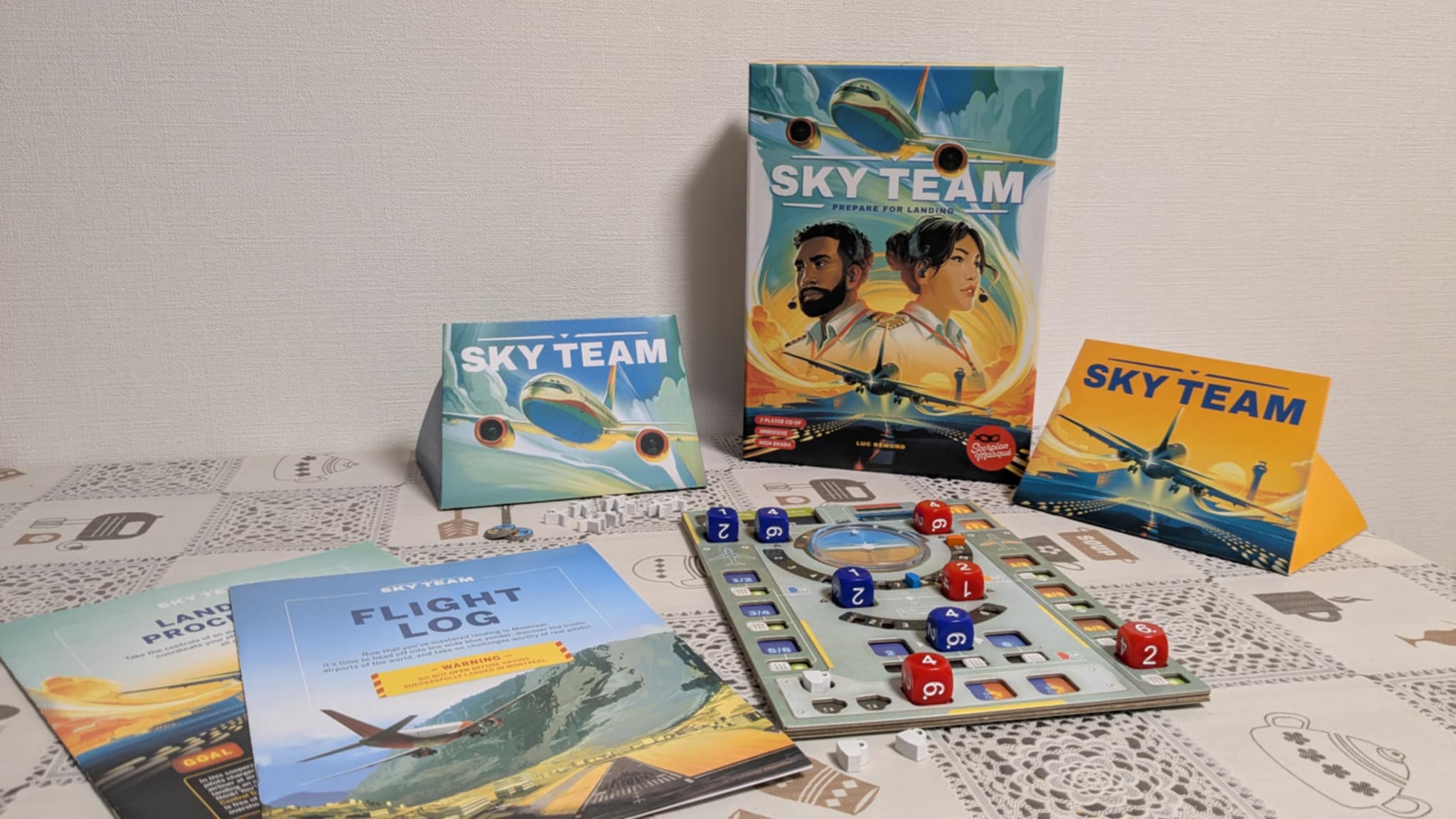
Conclusion
Sky Team soars high above expectations. With its clean interface, unique theme, and a core gameplay loop that builds tension through silence, it stands out in the crowded skies of modern board games. What begins as a simple dice placement mechanic evolves into a rich, emergent puzzle of timing, teamwork, and high-stakes landings. Add to that a generous campaign of new modules and scenarios, and you’ve got a game that delivers lasting value in an impressively compact package. Whether you’re a seasoned strategist or a casual duo looking for excitement, Sky Team offers an unforgettable co-op experience.
Alternative recommendations:
Another excellent co-op game that limits communication is The Crew, a fan-favorite with incredible replayability. Regicide also shines in the same space and can’t be recommended enough. If you want something with more of a party vibe, Mysterium and Mysterium Park offer visual deduction in lush settings. For two-player game fans, both Patchwork and Splendor Duel deliver smart design and eye-catching components. If what you love is reading dice and timing your plays just right, The Red Cathedral is a gem worth building with.
Final rating: 9.5/10
Pros:
- One of the best game interfaces/presentations
- Strong and satisfying core gameplay
- Generous campaign with tons of new mechanics
- Highly thematic and cohesive
Cons:
- Slightly fiddly setup and teardown
- Flimsy insert
- Occasionally too random or uncontrollable
Sky Team isn’t just a flight of fancy — it’s a masterfully designed descent into cooperative excellence.



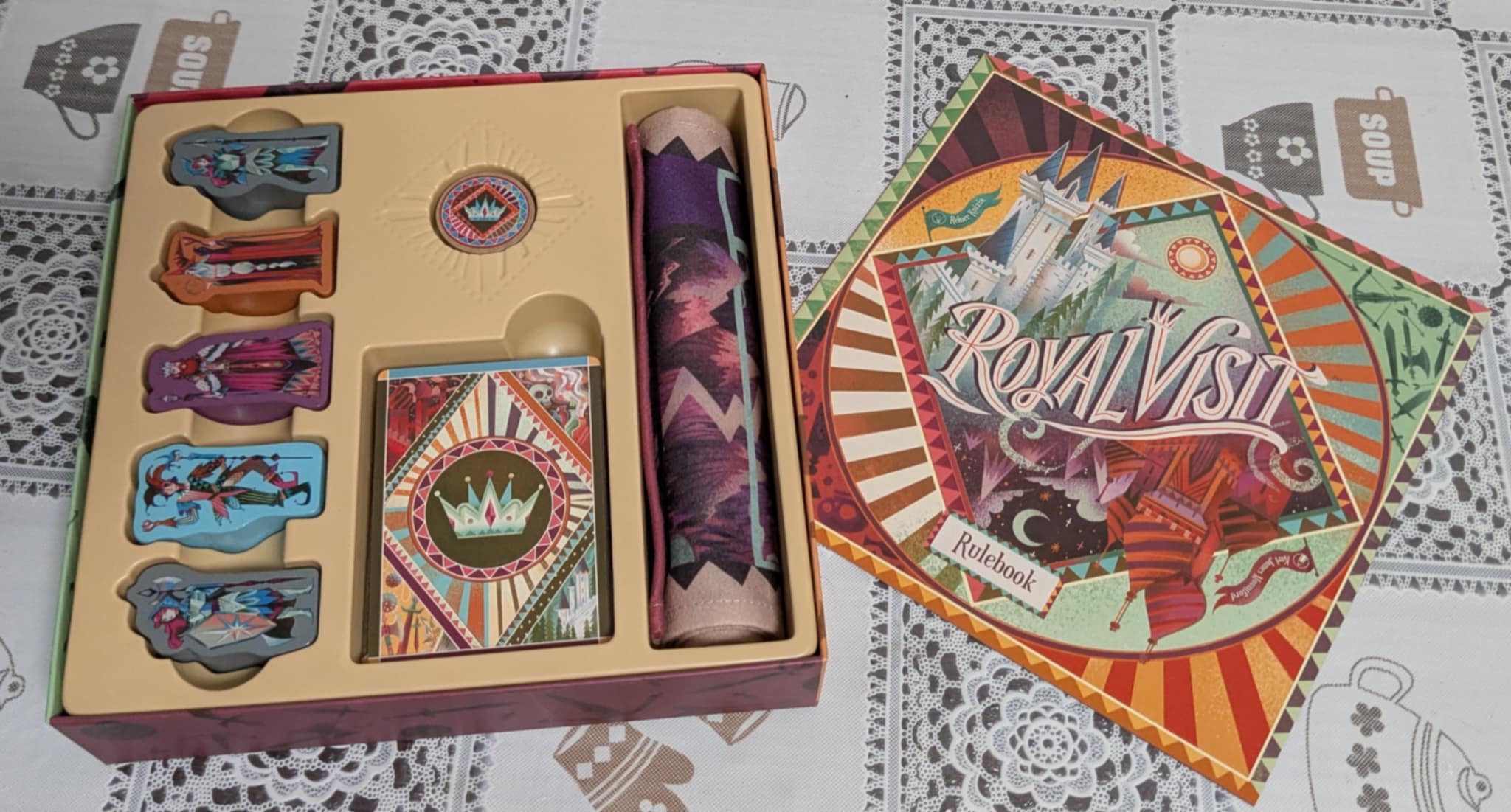
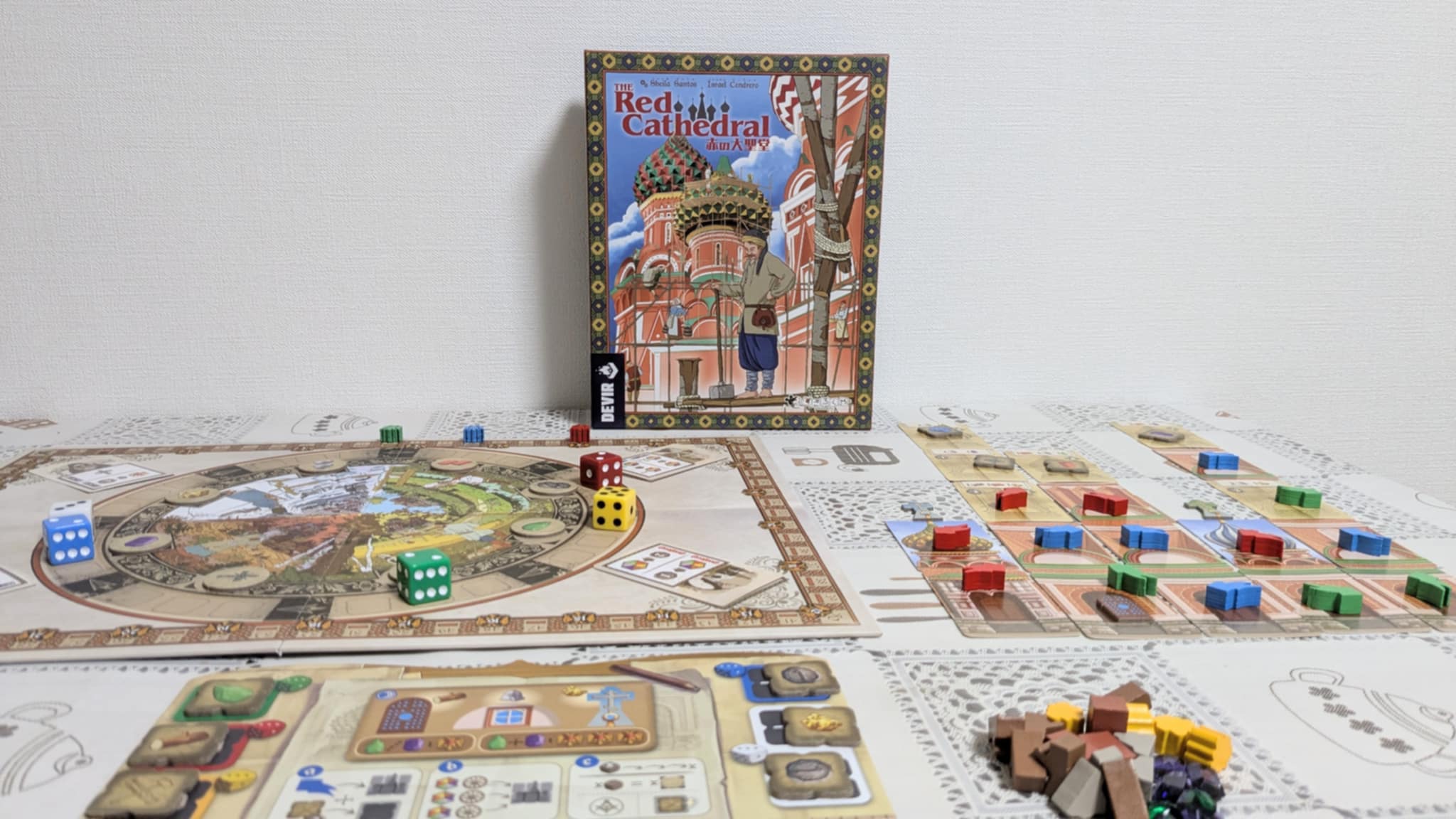
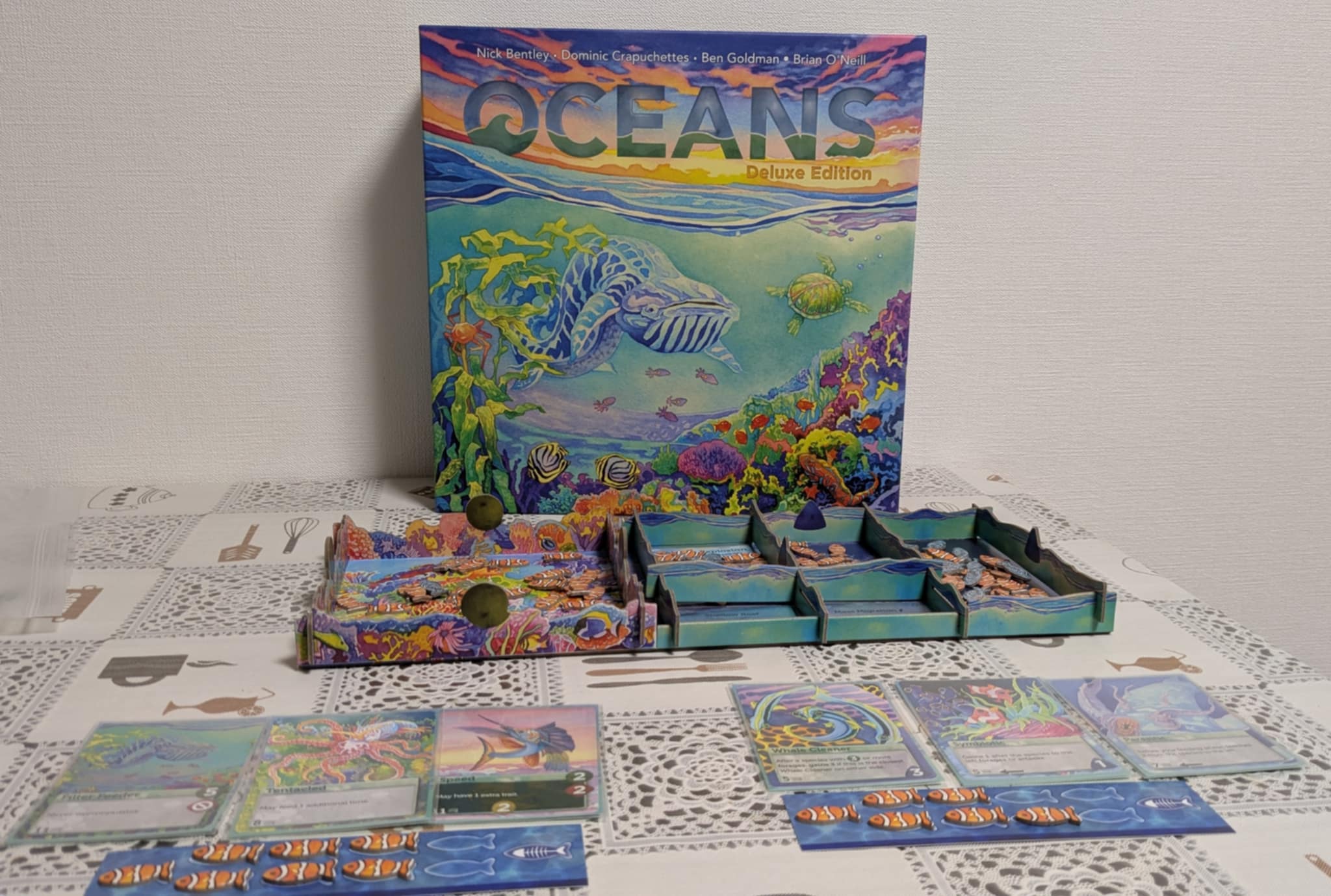
Leave a Reply